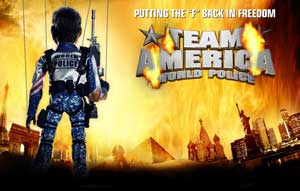Trey Parker and Matt Stone, the undisputed kings of construction paper animation chose not to create “Team America: World Police” with their favorite medium or even live actors, but marionettes. Puppets, which look remarkably like the stringed manequin-like marionettes of the children’s show Thunderbirds. Watching the film, it’s understandable as to why, because the mere undertaking of such as endeavor—the use of puppets in what amounts to be the parody of an action film—is hilarious. In an October interview in Cinema Confidential, Stone stated that the objective for the film was to tell a story from the point of view of puppets, puppets talking about terrorism and WMD’s, mocking not only the common devices of Bruckheimer-esque cinema, but the not so vast spectrum of American political discourse to boot.
Marionettes also add other layers which live action and animation cannot. The audience assesses the exploits of puppets much differently than with live action or animation. The three dimensional presence of a marionette in a more tangible setting which provides the filmmaker with more capacity to grip the audience’s sense of thrill and excitement with real explosions and blood splatters, but the movement of the marionettes themselves is hardly realistic, unlike even that of the animation of South Park. The idea to use puppets, however, is absurdly hilarious: an extended vomit scene along with a highly graphic sex scene (even though about 50% edited for the MPAA (waiting on that DVD!)) had the audience in deeper throws of laughter than typical animation is capable of inducing.
The kitschiness of the marionettes themselves adds to the humorousness of the film. They have a squeaky-clean doll-like quality with large eyes and perfect hair, caricatures of the even the most rote of Hollywood action films. The travel company Orbitz has capitalized on that same kitschy quality with the use of Thunderbirds-inspired marionettes in their recent commercials. But their marketing strategy may suffer some as their marionettes are now associated with those of Team America in the minds of the millions of Americans unfamiliar with the Thunderbirds. The ascetic looks of the puppets was important to Parker and Stone, particularly the eyes, which were from a glass eye maker. The large eyes gave them more leeway with the marionettes’ emotions, but motors inside the puppets’ heads helped the filmmakers along in this regard by controlling facial expressions. The abundant close-ups in the film, though awkward and strangely disconcerting, actually makes sense when the eyebrows and cheek muscles of the puppets undulate slightly.
The unfamiliarity of marionettes in cinema, though making the film funnier, still does not rest easy with most audiences. Marionettes cannot give us the idyllic comforts that animation can or the unconscious human-to-human subjectivity of live action. They are somewhere in between, tugging at the strings of the nether-regions of our subconscious, generally creeping us out, despite their welcoming countenances. It should be noted that the marionettes of Team America lose much of the creepiness seemingly inherent to all puppets because they do not interact with actual humans in the film like one would see in Child’s Play or Howdy Doody. They exist within a land of marionettes, far away from our own world, keeping their immobile, grotesque eyes and spindly limbs off of us and our unsuspecting children.
The overly earnest nature of the marionettes is apt for the satirical portrayal of a Hollywood action film with their overly handsome male characters and flat female roles. It is in these films where one would find the most unselfconscious acts of national chauvinism and it would seem they would be an apt stage for a left-wing deconstruction of contemporary American politics. But the movie isn’t about Anti-Bush/Bush, it’s “all about America,” as Trey Parker put it in the Cinema Confidential interview. In fact the film may have fell short of the comedy many of us appreciate in South Park because of an ongoing anguish with Parker and Stone over how much of a relevant political statement they wished to make. There was an attempt to write Bush into the film for several weeks, but the idea was eventually scrapped to essentially widen the film’s point of view.
The sardonic tirade many of us were hoping for also never came to be as the film simply pits the idealisms of both conservatives and liberals against each other by using bitterly derogatory stereotypes of each side. Because of this, the film can be either very funny or very insulting for both sides as the stereotypes may anger some, like Sean Penn. Though, it may be argued that liberals did receive a harder punishment as there is no redemption for them in the film. The likes of Janeane Garofalo and George Clooney take up arms against Team America in the film, unwittingly becoming the pawns of Kim Jung-Il in his endeavor to take over the world. Particularly humorous, however, is the scene where a ham stuffed marionette of Michael Moore, the character having become a suicide bomber, is blown up inside the Team America headquarters. The Team itself is naïvely jingoistic, so much so you almost feel sorry for them in the same way you might for a guy like George W. Bush, if he wasn’t given the responsibility of being the United States’ president. Their jingoism and not-so-deft combating of terrorists (the Louvre is destroyed in order to catch a fleeing terrorist holding a ‘WMD’) is a jibe at American foreign policy and the source of much of the film’s humor. However, as the Team emerges victorious—Kim Jung-Il and the liberals now defeated—the story’s heroes are now clear. But if you truly enjoyed the Team, and thought they were a fitting presentation of true Americans, I am afraid you might not have been the target audience for the film. But who can’t enjoy a little puppet humor— I’m putting Meet the Feebles in my queue ASAP!
Christian Holland is a regular contributor to Big, Red & Shiny.



